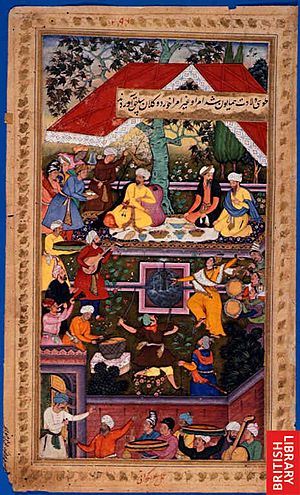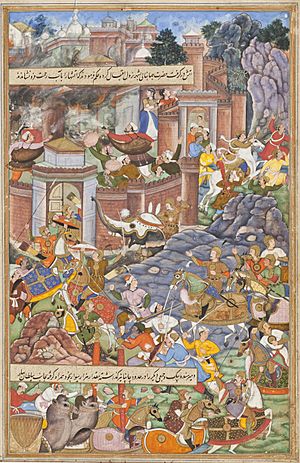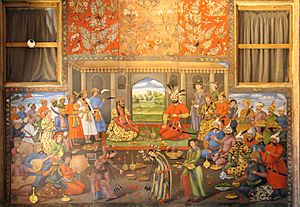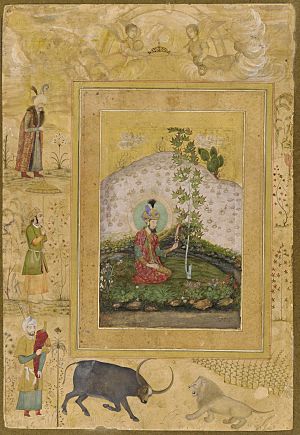Humayun facts for kids
Quick facts for kids Humayunهمایون |
|||||||||
|---|---|---|---|---|---|---|---|---|---|
| Padishah Al-Sultan Al-Azam |
|||||||||
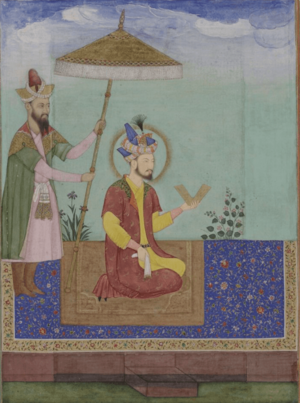
Humayun with an attendant
|
|||||||||
| 2nd Emperor of the Mughal Empire | |||||||||
| 1st Reign | 26 December 1530 – 17 May 1540 | ||||||||
| Coronation | 29 December 1530, Agra | ||||||||
| Predecessor | Babur | ||||||||
| Successor | Sher Shah Suri (Suri dynasty) | ||||||||
| Heir-apparent | Al-aman Mirza | ||||||||
| 2nd Reign | 22 June 1555 – 27 January 1556 | ||||||||
| Predecessor | Adil Shah Suri | ||||||||
| Successor | Akbar | ||||||||
| Born | Nasir-ud-Din Muhammad 6 March 1508 Kabul (present-day Afghanistan) |
||||||||
| Died | 27 January 1556 (aged 47) Delhi, Mughal Empire (present-day India) |
||||||||
| Burial | Humayun's Tomb, Delhi, India | ||||||||
| Consort |
|
||||||||
| Wives |
|
||||||||
| Issue |
|
||||||||
|
|||||||||
| House | House of Babur | ||||||||
| Dynasty | |||||||||
| Father | Babur | ||||||||
| Mother | Maham Begum | ||||||||
| Religion | Islam | ||||||||
Mirza Nasir-ud-Din Muhammad (also known as Humāyūn) was the second emperor of the Mughal Empire. He ruled over parts of what are now Afghanistan, Pakistan, Northern India, and Bangladesh. His first reign was from 1530 to 1540. He lost his empire but regained it later, ruling again from 1555 to 1556.
Like his father, Babur, Humayun faced many challenges. He lost his empire early on but got it back with help from the Safavid dynasty in Persia. By the time he died in 1556, the Mughal Empire covered almost one million square kilometers.
Humayun became emperor of the Mughal territories in India in December 1530. He was only 22 years old and didn't have much experience. His half-brother, Kamran Mirza, inherited Kabul and Kandahar, which were the northern parts of their father's empire. The two brothers later became strong rivals.
Humayun lost Mughal lands to Sher Shah Suri. But he got them back 15 years later with help from Persia. His return from Persia brought many Persian noblemen with him. This changed the Mughal court culture a lot. The Mughal dynasty's origins in Central Asia became less important. Instead, Persian art, architecture, language, and literature became very influential. Today, there are many stone carvings and thousands of Persian writings in India from Humayun's time.
Humayun quickly expanded the Empire even more after his return. He left a strong empire for his son, Akbar.
Contents
Early Life and Family
Humayun was born as Nasir-ud-Din Muhammad on March 6, 1508. His mother was Maham Begum, who was his father Babur's favorite wife. She was from a noble family in Khorasan.
Babur's decision to divide his empire among his sons was unusual in India. However, it was a common practice in Central Asia, going back to the time of Genghis Khan. Unlike many kingdoms where the oldest son inherited everything, the Timurids (Humayun's family) often divided their lands. This often led to fighting between family members.
When Babur died, Humayun's territories were not very secure. He had only ruled for four years. Not all the nobles saw Humayun as the rightful ruler. Some nobles had even tried to make his brother-in-law, Mahdi Khwaja, the ruler when Babur was sick. This attempt failed, but it showed that problems were coming.
Challenges in His First Reign
When Humayun became emperor, several of his brothers rebelled against him. Another brother, Khalil Mirza, supported Humayun but was killed.
Humayun had two main rivals for his lands. One was Sultan Bahadur of Gujarat in the southwest. The other was Sher Shah Suri (also called Sher Khan) in Bihar to the east.
Humayun's first military campaign was against Sher Shah Suri. But he had to stop this fight to deal with a threat from Ahmed Shah in Gujarat. Humayun won in Gujarat, taking over areas like Gujarat, Malwa, and the fort of Mandu.
In the first five years of Humayun's rule, Bahadur and Sher Khan expanded their own power. Bahadur of Gujarat got firearms from the Portuguese. The Mughals had gotten firearms from the Ottoman Empire.
In 1535, Humayun learned that the Sultan of Gujarat was planning to attack Mughal lands. Humayun gathered his army and marched against Bahadur. He quickly captured the forts of Mandu and Champaner. But instead of continuing his attack, Humayun stopped to secure the lands he had just won. Sultan Bahadur escaped and found safety with the Portuguese. In 1536, Bahadur Shah led a revolt and took back all of Gujarat. He then began to attack Malwa.
Facing Sher Shah Suri
Soon after Humayun went to Gujarat, Sher Shah Suri saw a chance to take control of Agra from the Mughals. He gathered his army to attack the Mughal capital. When Humayun heard this news, he quickly marched his troops back to Agra. This allowed Bahadur to easily regain the territories Humayun had just taken. In February 1537, Bahadur was killed during a failed attempt to kidnap the Portuguese viceroy.
Humayun managed to protect Agra from Sher Shah. However, the second most important city of the Empire, Gaur (the capital of Bengal), was attacked and looted. Humayun's troops were delayed trying to capture Chunar, a fort held by Sher Shah's son. This delay was meant to protect Humayun's army from attacks from behind. The huge grain stores in Gaur were emptied. The great wealth of Bengal was taken east, giving Sher Shah a lot of money for his war efforts.
Sher Shah moved east, but Humayun did not follow him right away. Humayun's 19-year-old brother, Hindal, had agreed to help in this battle and protect the rear. But he left his position and went back to Agra, where he declared himself the acting emperor. When Humayun sent a religious leader to talk to him, the leader was killed. Hindal further showed his rebellion by ordering that the sermon in the main mosque be changed.
Humayun's other brother, Kamran Mirza, marched from his lands in Punjab. He pretended to help Humayun. But he secretly planned to take over Humayun's weakening empire. He made a deal with Hindal, saying Hindal would stop rebelling in exchange for a share in the new empire Kamran would create.
In June 1539, Sher Shah met Humayun at the Battle of Chausa near Buxar. This was a long battle where both sides dug into their positions. Humayun's artillery (big guns) became stuck. Humayun tried to make a peace deal. He agreed to let Sher Shah rule Bengal and Bihar, but only as provinces given to him by Humayun, not as an independent ruler. They also made a deal to save face: Humayun's troops would charge, and Sher Shah's forces would pretend to retreat.
But after Humayun's army charged and Sher Shah's troops pretended to retreat, the Mughal soldiers relaxed. They went back to their camps without proper guards. Seeing this, Sher Shah broke his promise. That very night, his army attacked the Mughal camp. Most of the Mughal troops were asleep and unprepared, and they were killed. Humayun survived by swimming across the Ganges River using an air-filled "water skin." He quietly returned to Agra.
In Agra and Exile
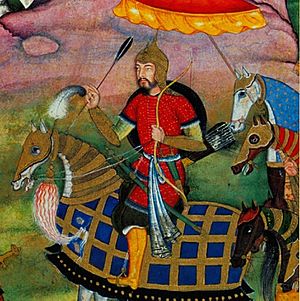
When Humayun returned to Agra, all three of his brothers were there. Humayun once again forgave his brothers for plotting against him, even Hindal for his open betrayal. Sher Shah was slowly getting closer to Agra. This was a serious threat to the whole family. But Humayun and Kamran argued about what to do. Kamran left after Humayun refused to attack the enemy quickly. Humayun wanted to build a larger army first.
When Kamran returned to Lahore, Humayun, with his brothers Askari and Hindal, marched to meet Sher Shah. They fought at the Battle of Kannauj on May 17, 1540. Humayun was badly defeated. He retreated to Agra, with Sher Shah following him, and then went through Delhi to Lahore. Sher Shah then founded the short-lived Sur Empire, with its capital in Delhi. This led to Humayun's exile for 15 years.
Retreating Further
The four brothers were together in Lahore. But they kept hearing that Sher Shah was getting closer. When Sher Shah reached Sirhind, Humayun sent a message saying, "I have left you all of Hindustan (lands east of Punjab). Leave Lahore alone, and let Sirhind be the border between us." Sher Shah replied, "I have left you Kabul. You should go there." Kabul was the capital of Humayun's brother Kamran's empire. Kamran was not willing to give any of his lands to Humayun. Instead, Kamran went to Sher Shah and offered to rebel against Humayun and side with Sher Shah. In return, he wanted most of the Punjab. Sher Shah refused his help. But word of Kamran's betrayal reached Lahore. Humayun was urged to punish Kamran, but he refused. He remembered his father Babur's last words: "Do nothing against your brothers, even though they may deserve it."
Humayun decided it was best to retreat even further. He and his army rode through the Thar Desert. The Hindu ruler Rao Maldeo Rathore had allied with Sher Shah Suri against the Mughals. Humayun often described how he and his pregnant wife had to travel through the desert in the hottest part of the year. They had little food and water. When Hamida Bano's horse died, no one would lend the Queen (who was eight months pregnant) a horse. So Humayun gave her his own horse and rode a camel for six kilometers. Humayun later called this the lowest point in his life.
Humayun asked his brothers to join him as he fell back into Sindh. Hindal Mirza, who had been rebellious before, remained loyal and was ordered to join his brothers in Kandahar. But Kamran Mirza and Askari Mirza decided to go to Kabul, which was peaceful. This created a permanent split in the family.
Humayun went to Sindh because he expected help from the Emir of Sindh, Hussein Umrani. Humayun had appointed him, and Hussein owed him loyalty. Also, Humayun's wife Hamida was from Sindh. She was the daughter of a respected religious family of Persian heritage who had lived in Sindh for a long time. On the way to the Emir's court, Humayun had to stop because his pregnant wife Hamida could not travel further. Humayun found safety with the Hindu ruler of the oasis town of Amarkot.
Rana Prasad Rao of Amarkot welcomed Humayun and sheltered the refugees for several months. Here, in the home of a Hindu nobleman, Humayun's wife Hamida Bano gave birth to their son, the future Emperor Akbar, on October 15, 1542. This date is well known because Humayun consulted his astronomer to check the planets' positions. The baby was the long-awaited heir for the 34-year-old Humayun. Soon after Akbar's birth, Humayun and his group left Amarkot for Sindh, leaving Akbar behind. He was too young for the difficult journey. Akbar was later adopted by Askari Mirza.
For once, Humayun was not disappointed by the person he trusted. Emir Hussein Umrani, the ruler of Sindh, welcomed Humayun and was loyal to him. While in Sindh, Humayun and Hussein Umrani gathered horses and weapons. They formed new alliances that helped Humayun regain lost territories. Eventually, Humayun gathered hundreds of Sindhi and Baloch tribesmen, along with his Mughals. He then marched towards Kandahar and later Kabul. Thousands more joined him as Humayun kept declaring himself the rightful Timurid heir of the first Mughal Emperor, Babur.
Return to Kabul
After his expedition in Sindh, Humayun set out to join his brothers in Kandahar. He had 300 camels and 2000 loads of grain. He crossed the Indus River on July 11, 1543, hoping to regain the Mughal Empire and overthrow the Suri dynasty. Many tribes, including the Leghari, Magsi, and Rind, swore loyalty to Humayun.
In Kamran Mirza's territory, Hindal Mirza had been placed under house arrest in Kabul. This was because he refused to have the sermon read in Kamran Mirza's name. Humayun's other brother, Askari Mirza, was ordered to gather an army and march on Humayun. When Humayun heard about the approaching enemy army, he decided not to fight them. Instead, he sought safety elsewhere. Akbar was left behind near Kandahar. It was December, too cold and dangerous to take the 14-month-old child through the mountains. Askari Mirza took Akbar in, and Kamran and Askari Mirza's wives raised him.
Humayun again turned towards Kandahar, where his brother Kamran Mirza was in power. But he received no help and had to seek safety with the Shah of Persia.
Seeking Help in Persia
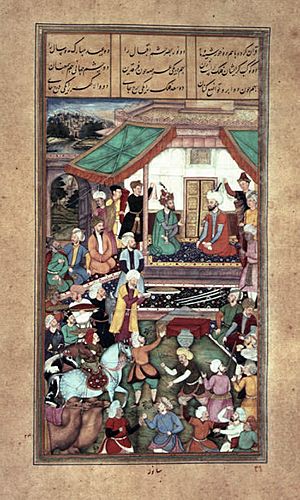
Humayun fled to the Safavid Empire in Persia. He traveled with 40 men, his wife Bega Begum, and her companion through mountains and valleys. They even had to eat horse meat boiled in soldiers' helmets. These hardships continued for a month until they reached Herat. After arriving, they were treated very well. His army was greeted with an armed escort, and they received lavish food and clothing. They were given fine places to stay, and the roads were cleaned for them.
The Shah, Tahmasp I, unlike Humayun's own family, welcomed the Mughal emperor. He treated him like a royal visitor. Humayun went sightseeing and was amazed by the Persian artwork and architecture. Much of this was the work of his relatives and ancestors, so he could admire their creations firsthand.
Humayun was introduced to the work of Persian miniature artists. Two of their students joined Humayun's court. Humayun was so impressed that he asked if they would work for him if he regained his empire in India, and they agreed. Humayun did not even meet Tahmasp until July, about six months after arriving in Persia. After a long journey from Herat, the two met in Qazvin, where a big feast and parties were held. A famous wall painting in the Chehel Sotoun palace in Esfahan shows the meeting of the two emperors.
Tahmasp urged Humayun to convert from Sunni to Shia Islam to save himself and his followers. The Mughals at first disagreed, but they knew that by outwardly accepting Shi'ism, Tahmasp would offer Humayun more significant support. When Humayun's brother, Kamran Mirza, offered to give Kandahar to the Persians in exchange for Humayun (dead or alive), Tahmasp refused. Instead, he held a celebration with 300 tents, a royal Persian carpet, 12 musical bands, and "meat of all kinds." Here, the Shah announced that all this, plus 12,000 elite cavalry, were Humayun's to lead an attack on Kamran. All Tahmasp asked was that if Humayun's forces won, Kandahar would be his.
Regaining Power

With this Persian help, Humayun took Kandahar from Askari Mirza after a two-week siege. He noticed how the nobles who had served Askari Mirza quickly came to serve him. Kandahar was given to the Shah of Persia as agreed. The Shah sent his infant son, Murad, as the viceroy. However, the baby soon died, and Humayun felt strong enough to take control of Kandahar himself.
Humayun then prepared to take Kabul, which was ruled by his brother Kamran Mirza. In the end, there was no real siege. Kamran Mirza was disliked as a leader. As Humayun's Persian army approached the city, hundreds of Kamran's troops switched sides and joined Humayun. Kamran Mirza ran away and started building an army outside the city. In November 1545, Hamida and Humayun were reunited with their son Akbar, and they held a huge celebration.

Even though Humayun had a larger army than Kamran Mirza and had the advantage, his poor military decisions twice allowed Kamran to retake Kabul and Kandahar. This forced Humayun to launch more campaigns to get them back. Humayun was known for being lenient towards the troops who had defended the cities against him. Kamran Mirza, on the other hand, was known for his cruel acts against the people who he thought had helped his brother.
His youngest brother, Hindal Mirza, who had been the most disloyal, died fighting for Humayun. His brother Askari Mirza was put in chains by his nobles and helpers. He was allowed to go on a religious pilgrimage (Hajj) and died on the way in the desert.
Humayun's other brother, Kamran Mirza, had tried to have him killed many times. In 1552, Kamran Mirza tried to make a deal with Islam Shah, Sher Shah's successor. But he was caught by a Gakhar chief. The Gakhars were one of the few tribal groups who had always stayed loyal to the Mughals. Sultan Adam of the Gakhars handed Kamran Mirza over to Humayun. Humayun wanted to forgive Kamran Mirza. But he was warned that letting his brother's repeated betrayals go unpunished could cause rebellion among his own supporters. So, instead of killing Kamran Mirza, Humayun had him blinded. This ended any claim Kamran had to the throne. He then sent Kamran Mirza on Hajj, hoping his brother would be forgiven for his wrongs. Kamran Mirza died near Mecca in 1557.
Restoring the Mughal Empire
Sher Shah Suri died in 1545, and his son and successor Islam Shah died in 1554. These deaths caused the Suri dynasty to fall apart. Three rivals for the throne marched on Delhi, and many city leaders tried to declare independence. This was a perfect chance for the Mughals to return to India.
Emperor Humayun gathered a large army to retake the throne in Delhi. Because of the Safavid help, most of Humayun's army followed the Shi'a faith. Humayun put the army under the command of Bairam Khan. This was a smart move, as Humayun was not always the best military leader. Bairam Khan proved to be a great tactician. At the Battle of Sirhind on June 22, 1555, the armies of Sikandar Shah Suri were completely defeated. The Mughal Empire was re-established in India.
Bairam Khan led the army through the Punjab with almost no resistance. The Rohtas Fort, built by Sher Shah Suri to crush the Gakhars loyal to Humayun, was surrendered without a fight by a disloyal commander. The fort walls are very thick and tall, extending for 4 kilometers with 68 bastions. Its grand sandstone gates influenced later Mughal military architecture.
The only major battle Humayun's armies faced was against Sikander Suri in Sirhind. Bairam Khan used a clever tactic: he engaged the enemy in open battle, then quickly retreated as if scared. When the enemy followed, they were surprised by hidden defensive positions and easily defeated.
After Sirhind, most towns and villages welcomed the invading army as it moved towards the capital. On July 23, 1555, Humayun once again sat on Babur's throne in Delhi.
His Character
Edward S. Holden wrote that Humayun was "always kind and thoughtful to his servants." He was "very devoted to his son Akbar, to his friends, and to his difficult brothers." Holden believed that the problems in his reign came largely from him not being strict enough with his brothers. He also wrote that Humayun's flaws as a ruler make him more likable as a person. His fame suffered because his reign was between the great conquests of Babur and the wise rule of Akbar. But he was worthy to be the son of one and the father of the other.
Stanley Lane-Poole wrote in his book Medieval India: "His name meant the winner (Lucky/Conqueror), there is no king in the history to be named as wrong as Humayun." He was a forgiving person. Lane-Poole also wrote, "He was in fact unfortunate... He had barely enjoyed his throne for six months in Delhi when he slipped down from the polished steps of his palace and died at 49 (Jan. 24, 1556). If there was a possibility of falling, Humayun was not the man to miss it. He tumbled through his life and tumbled out of it."
Death and Legacy
On January 24, 1556, Humayun was carrying books and going down the stairs from his library, Sher Mandal. The muezzin (person who calls to prayer) announced the Azaan (the call to prayer). It was Humayun's habit to kneel in respect whenever he heard the call. As he tried to kneel, his foot caught in his robe. He slipped down several steps and hit his head on a stone edge. He died three days later.
His body was first buried in Purana Quila. But because of an attack by Hemu on Delhi, Humayun's body was moved by the fleeing army to Kalanaur in Punjab. This is where Akbar was crowned emperor. After young Mughal emperor Akbar defeated and killed Hemu in the Second Battle of Panipat, Humayun's body was buried in Humayun's Tomb in Delhi. This was the first very grand garden tomb in Mughal architecture. It set an example for later monuments like the Taj Mahal. His favorite and devoted chief wife, Bega Begum, ordered its construction.
Akbar later asked his paternal aunt, Gulbadan Begum, to write a biography of his father Humayun. This book is called the Humayun nameh (or Humayun-nama). It also included what she remembered of Babur.
The full title is Ahwal Humayun Padshah Jamah Kardom Gulbadan Begum bint Babur Padshah amma Akbar Padshah. She was only eight when Babur died and was married at 17. Her work is written in a simple Persian style.
Unlike other Mughal royal biographies, no richly illustrated copy of her work has survived. The book is known only from a single damaged and slightly incomplete manuscript, which is now in the British Library. It was found in the 1860s. Annette Beveridge published an English translation in 1901. Editions in English and Bengali have been published since 2000.
See also
 In Spanish: Humayun para niños
In Spanish: Humayun para niños
- Humayun (film)
- Persian Inscriptions on Indian Monuments


